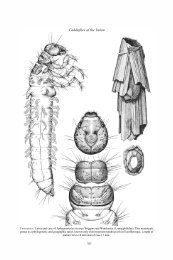(Ephemeroptera) of the Yukon - Department of Biological Sciences
(Ephemeroptera) of the Yukon - Department of Biological Sciences
(Ephemeroptera) of the Yukon - Department of Biological Sciences
You also want an ePaper? Increase the reach of your titles
YUMPU automatically turns print PDFs into web optimized ePapers that Google loves.
164 P.P. Harper and F. Harper<br />
faunas <strong>of</strong> both sides <strong>of</strong> <strong>the</strong> Pacific Rim are critically compared. The situation, however,<br />
appears to be very similar in Alaska (McCafferty 1985, 1994), where detailed collections<br />
are also still scanty.<br />
As many <strong>of</strong> <strong>the</strong> Holarctic species are confined to nor<strong>the</strong>rn latitudes, and because <strong>the</strong>ir<br />
distribution appears to be centred in <strong>the</strong> west ra<strong>the</strong>r than <strong>the</strong> east, it has generally been<br />
hypo<strong>the</strong>sized that <strong>the</strong>y have colonized North America from northwestern refugia (Lehmkuhl<br />
1980), though Flannagan and Flannagan (1984) suggest a variety <strong>of</strong> migration routes from<br />
<strong>the</strong> east, <strong>the</strong> west or <strong>the</strong> south. Cobb and Flannagan (1980) also suggest earlier (pre-glacial)<br />
colonization through a north Atlantic route for some <strong>of</strong> <strong>the</strong>m; <strong>the</strong>re is little evidence <strong>of</strong> this<br />
at present. Species <strong>of</strong> special interest in this context are those that appear to be confined to<br />
<strong>the</strong> Northwest Territories, never having been collected ei<strong>the</strong>r eastwards or westwards; such<br />
are Baetis foemina—which extends into <strong>the</strong> Mackenzie drainage (Moore 1977)—and Baetis<br />
hudsonicus.<br />
Cobb and Flannagan (1980) relate <strong>the</strong> low diversity <strong>of</strong> <strong>the</strong> mayfly faunas <strong>of</strong> nor<strong>the</strong>rn<br />
latitudes to <strong>the</strong> difficulty <strong>of</strong> adult dispersal in cold wea<strong>the</strong>r conditions; colonization is<br />
<strong>the</strong>refore thought to be mainly through aquatic routes in <strong>the</strong> nymphal stage. This reliance on<br />
connections between drainage systems for dispersal may be a partial explanation <strong>of</strong> <strong>the</strong><br />
decreased diversity, but habitat conditions (treeline, winter icing, availability <strong>of</strong> resources)<br />
are certainly involved (Harper 1981; Danks 1990). Corkum and Ciborowski (1988) showed<br />
a high correlation between environmental variables such as river size, velocity, slope,<br />
latitude, and conductivity, and mayfly distributions.<br />
The majority <strong>of</strong> species are <strong>of</strong> western origin, and typically are distributed along <strong>the</strong><br />
Cordillera and <strong>the</strong> western mountain ranges. The taxa collected up to now in <strong>the</strong> <strong>Yukon</strong> are<br />
<strong>the</strong> hardier elements <strong>of</strong> this fauna; in <strong>the</strong> western United States, <strong>the</strong>se species typically are<br />
widespread and generally inhabit <strong>the</strong> boreal zone above 1200 –1500 m. Both lotic and lentic<br />
species are involved, but <strong>the</strong> majority <strong>of</strong> species inhabit running waters; <strong>the</strong> major stagnantwater<br />
elements are Callibaetis ferrugineus hageni, Leptophlebia spp., Metretopus borealis<br />
and Siphloplecton sp. (6, 22, 24, 25), but all, except perhaps <strong>the</strong> first, can be found in slow<br />
streams and stream pools. Conversely, many <strong>of</strong> <strong>the</strong> lotic species can colonize cold lakes,<br />
particularly rocky shores.<br />
The data presented here are yet too scanty for generalizations and <strong>the</strong> casual collections<br />
can in no way allow any discussion <strong>of</strong> species distribution within <strong>the</strong> <strong>Yukon</strong> Territory.<br />
Corkum (1989) has recently presented a classification <strong>of</strong> northwestern streams based on<br />
benthic invertebrate assemblages. <strong>Yukon</strong> streams fall within her categories “d” and “e”; <strong>the</strong><br />
former prevails over most <strong>of</strong> <strong>the</strong> <strong>Yukon</strong> Territory and is characterized by an abundance <strong>of</strong><br />
Oligochaeta; <strong>the</strong> mayflies belong mainly to <strong>the</strong> families Baetidae and Heptageniidae, with<br />
some Ephemerellidae, Siphlonuridae (s. lat.), Caenidae (and Tricorythidae), <strong>the</strong> same groups<br />
as in our list. The less common “e” group <strong>of</strong> streams is characterized by a dominance <strong>of</strong><br />
Rhyacophilidae (Trichoptera) and Systellognatha (Plecoptera); <strong>the</strong> mayflies belong, in<br />
decreasing importance, to <strong>the</strong> families Heptageniidae, Baetidae, Ephemerellidae and<br />
Siphlonuridae (s. lat.). These results are but a preliminary insight into <strong>the</strong> fauna <strong>of</strong> a large<br />
and diverse territory. The <strong>Yukon</strong> is potentially a very interesting region for a study <strong>of</strong> <strong>the</strong><br />
zoogeography <strong>of</strong> mayflies, as it sits at <strong>the</strong> junction <strong>of</strong> <strong>the</strong> eastern, western, and arctic faunas.<br />
It is particularly important because it may have played a role in <strong>the</strong> postglacial recolonization<br />
<strong>of</strong> nor<strong>the</strong>rn latitudes. More extensive collecting will, however, be needed before any serious<br />
investigation <strong>of</strong> <strong>the</strong>se relationships can be undertaken.
















